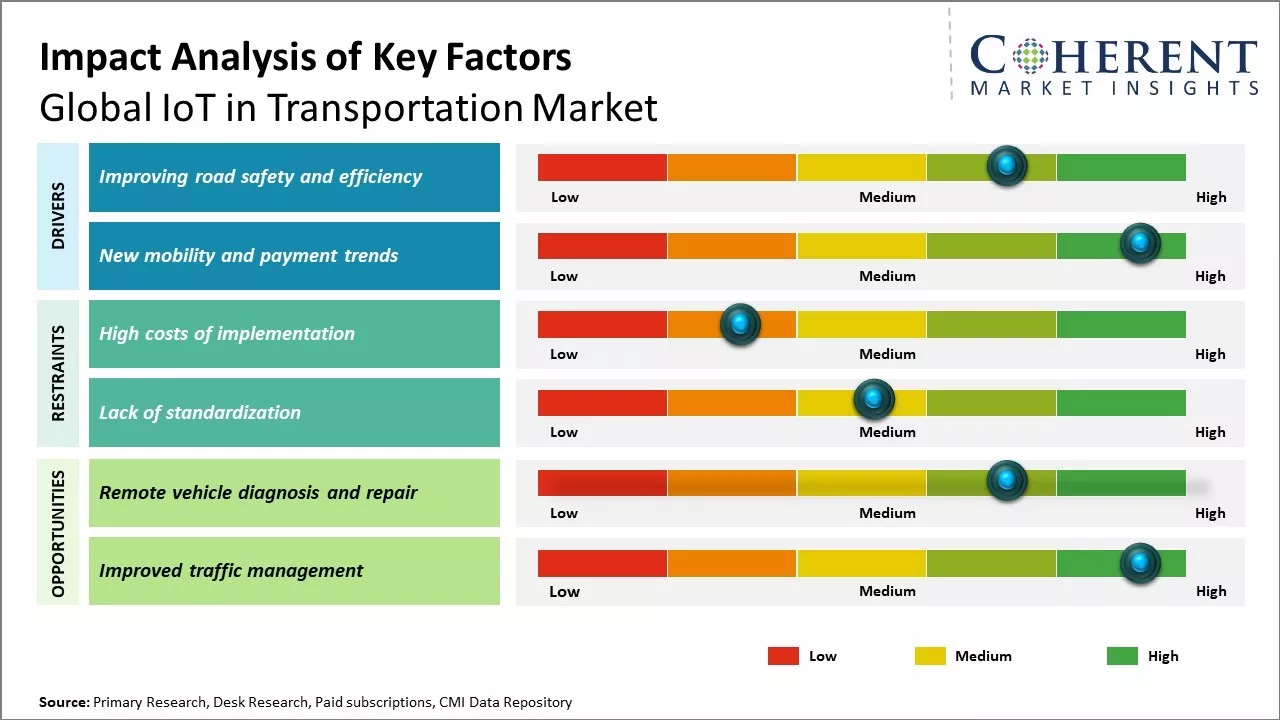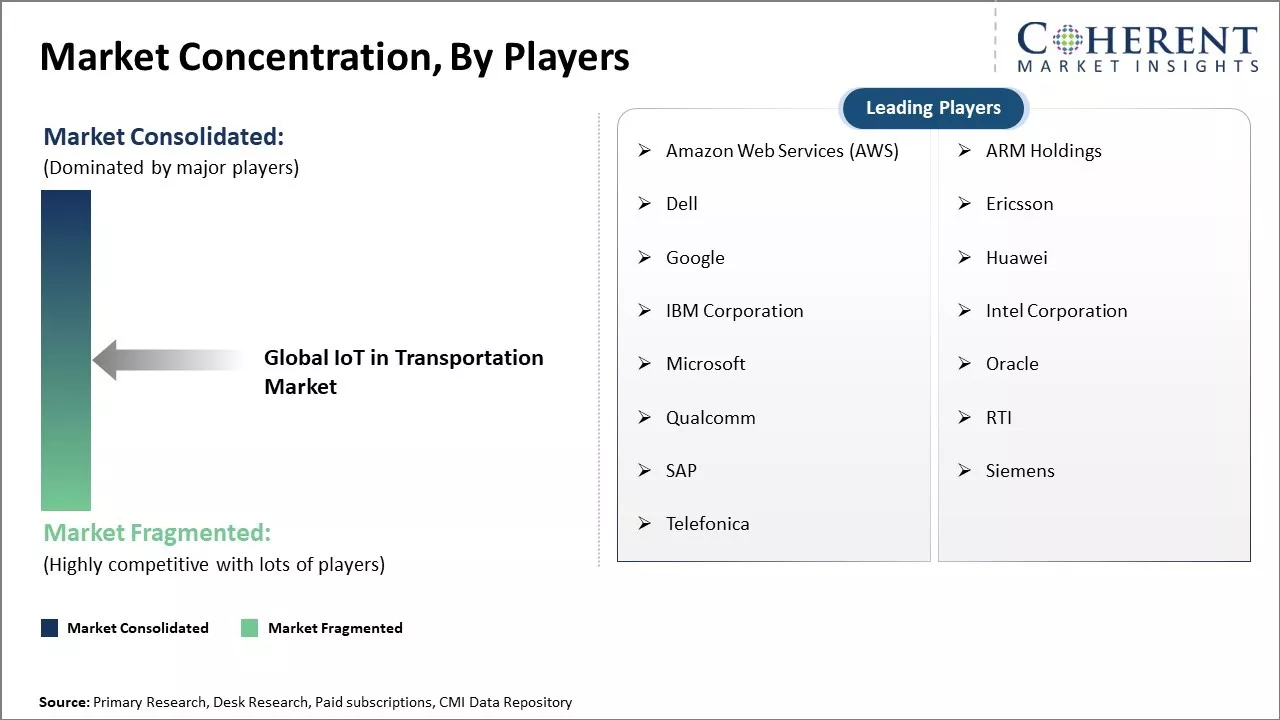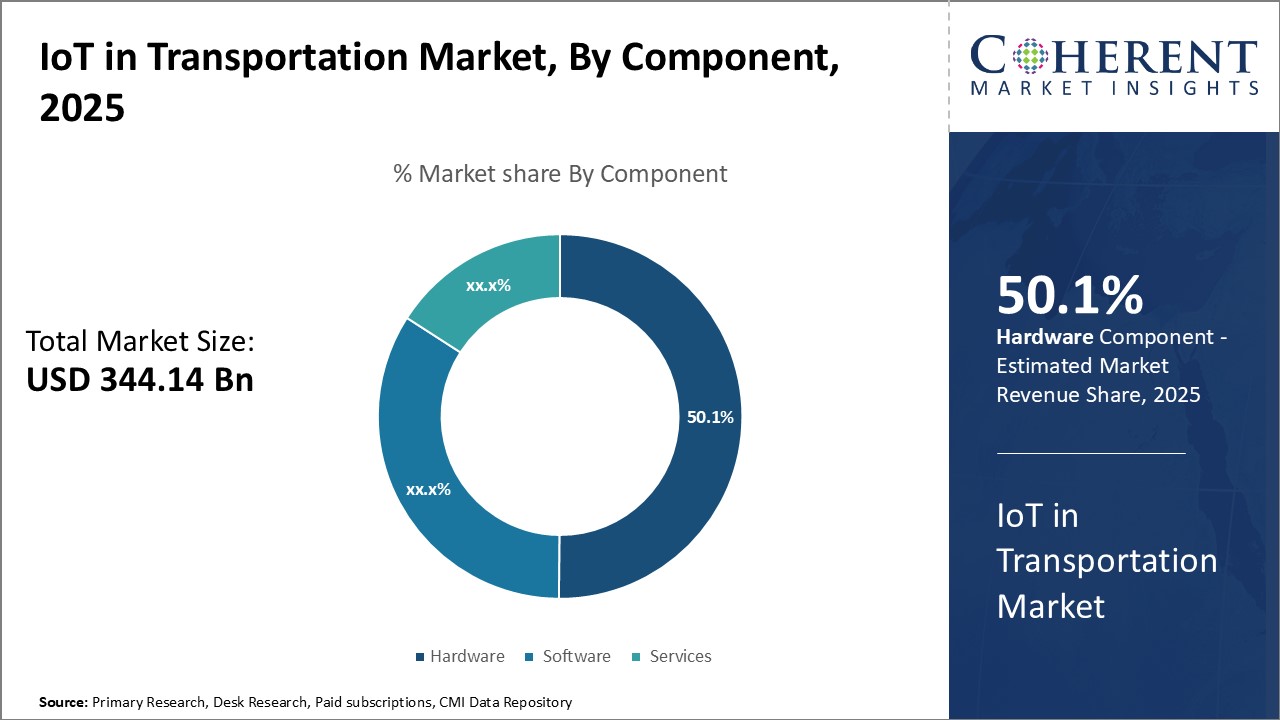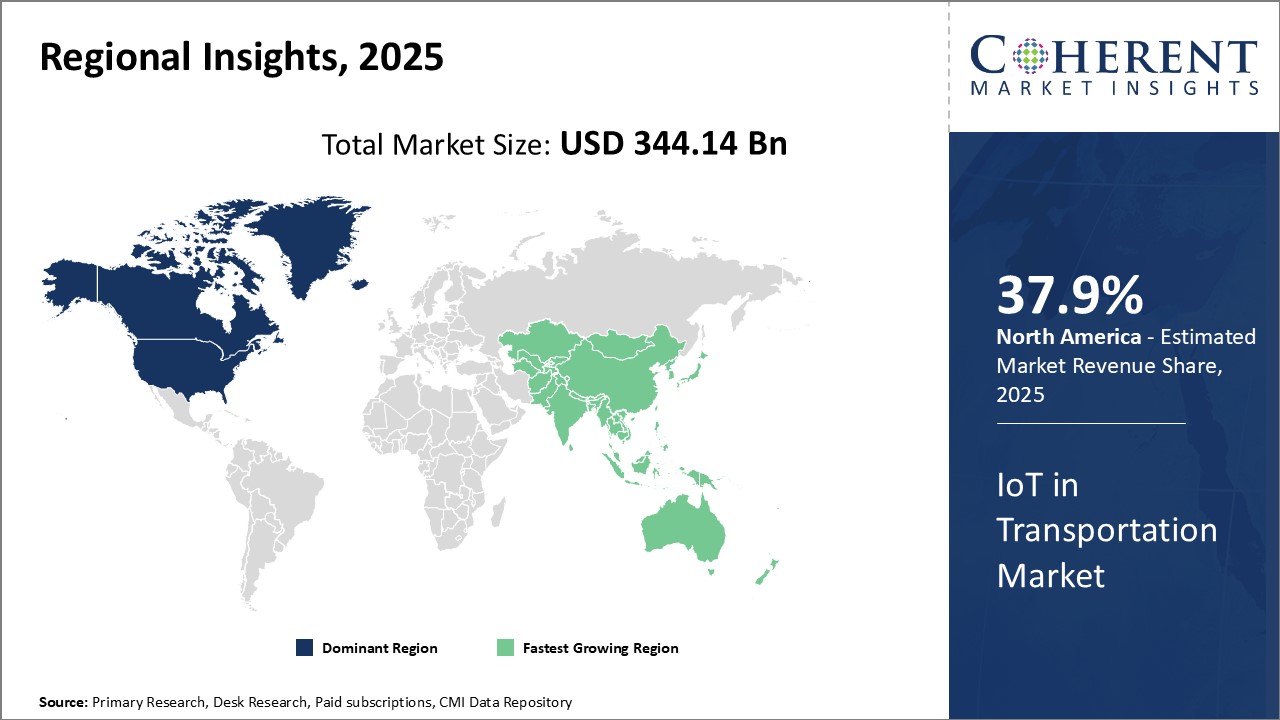IoT In Transportation Market Size and Trends
Global IoT in transportation market is estimated to be valued at US$ 344.14 Bn in 2025 and is expected to reach US$ 877.66 Bn by 2032, exhibiting a compound annual growth rate (CAGR) of 14.3% from 2025 to 2032.

Discover market dynamics shaping the industry: Download Free Sample
Global IoT in transportation market growth is driven by rising adoption of autonomous and connected vehicles technologies. Key market players are investing heavily in development of advanced telematics solutions to track vehicle performance, driver behavior, and fleet management. Moreover, integration of IoT with transportation infrastructure enable applications like smart traffic management, toll collection, and logistics & supply chain optimization. Development of smart cities & urban mobility coupled with increasing penetration of connected vehicles can boost demand for IoT in transportation systems. Standardization of technologies and development of 5G infrastructure can also drive the market growth during the forecast period.
Improving road safety and efficiency
Rising adoption of internet of things or IoT technologies in the transportation sector can improve road safety and traffic efficiency. Connected vehicles can share real-time information about road conditions, weather updates, traffic incidents and hazards with each other that helps in preventing accidents. Drivers get early warnings about obstacles ahead like stopped traffic or vehicles changing lanes suddenly. The use of sensors, radar and cameras by connected cars also improves situation awareness for drivers. Transport authorities and traffic controllers can remotely monitor traffic flows and road conditions. These can timely detect emergencies or crashes and redirect traffic to alternative routes to prevent congestion. This leads to less time stuck in traffic and less fuel wasted. Authorities also get real-time information to handle evacuations better during emergencies like floods, earthquakes or other disasters.
Automakers are equipping cars with advanced driver assistance systems that use technologies like automatic braking, blind spot monitoring cameras to take autonomous corrective actions and prevent accidents. As more IoT sensors get integrated into critical transport infrastructure like roads, bridges and tunnels, structural problems can be identified early on. This improves maintenance efficiency. With real-time alerts about road works or lane closures, drivers can plan their journeys better to avoid delays. All these factors help in significantly lowering the number of road accidents every year globally. Thus, reduced traffic jams translate to huge savings of time and fuel for both individual commuters as well as transport and logistics companies. This makes transportation more efficient and sustainable.
Market Concentration and Competitive Landscape

Get actionable strategies to beat competition: Download Free Sample
New mobility and payment trends
Rapid adoption of IoT technologies in transport is driven by new mobility trends and demands from consumers for smarter, personalized mobility solutions. The preference for shared, on-demand and low-cost mobility has led to rise of shared mobility services like ride-hailing and car-sharing that are heavily dependent on IoT connectivity. Being connected allows such fleet vehicles to be seamlessly booked, tracked and paid for digitally using mobile apps. It has made mobility more affordable and flexible as compared to traditional public or private transport. IoT enabled shared electric scooters and bikes have gained popularity globally as people prefer short point-to-point trips within cities.
Key Takeaways from Analyst:
Global IoT in transportation market growth is driven by factors like increasing adoption of connected vehicles, focus on operational efficiency and improved transportation infrastructure. However, data privacy and security concerns can hamper the growth of IoT solutions in this industry.
North America dominates the market due to widespread technology adoption and presence of automotive giants. However, Asia Pacific is likely to emerge as the fastest growing regional market with China playing a major role. Growing middle class population and their rising disposable incomes can boost IoT spending in the APAC transportation sector.
IoT allows transportation providers to track vehicle movements, monitor driver behavior, automate maintenance schedules and optimize fuel usage, which lowers the operational costs. IoT is used for traffic management as IoT aids in reducing congestion and improving road safety through integrated traffic signals and road sensors.
Rising adoption of IoT solutions for passenger transportation like connected buses and metros can enhance traveller experience through real-time travel updates and digital payment options. Widespread use of IoT has the potential to make entire transport infrastructure far more efficient, green and optimally utilized through technologies like connected vehicles.
Market Challenges: High costs of implementation
The high costs of implementation can hamper the global IoT in transportation market growth. Setting up the required IoT infrastructure for transportation involves significant investment which includes the costs associated with sensors, network connectivity, data storage, data processing and security management. For large scale transportation systems spanning across cities, countries or continents, the infrastructure development costs run into hundreds of millions if not billions of dollars.
Transportation operators, whether public or private, need to install a wide array of sensors at various points to monitor vehicles, traffic, passenger movement, and others. These sensors communicate over wireless networks requiring investments in network equipment and connectivity. The data generated is massive in volume and velocity which needs sophisticated tools and systems for efficient collection, transmission, storage and analysis of this data. Moreover, stringent security and privacy standards are mandated for such critical infrastructure to protect the data from cyber threats, which further adds to the capital expenditure.
Market Opportunities: Remote vehicle diagnosis and repair
Remote vehicle diagnosis and repair can offer opportunity for global IoT in transportation market growth. As vehicles become more advanced with the integration of various sensors and connectivity capabilities, it allows the monitoring of vehicles in real-time. This enables the ability to diagnose potential issues remotely even before the driver is aware. With advancements in technology like 5G networks, more seamless information exchange can take place between the vehicle and diagnostic centers. Remote diagnostics and monitoring of fleet vehicles can detect faults early and schedule repairs proactively. This improves uptime and reduces downtime costs significantly for fleet operators.
Service centers can obtain live vehicle data and diagnose problems remotely rather than waiting for the vehicle to be physically brought in. This saves time otherwise spent on physical checkups and allows for a more efficient utilization of technician resources. As vehicles send vast amounts of operational data continuously, AI tools can analyze patterns and provide predictive maintenance alerts. This helps avoid unexpected breakdowns and improves road safety.

Discover high revenue pocket segments and roadmap to it: Download Free Sample
Insights By Component- Ubiquitous adoption of sensors boosts demand for hardware
In terms of component, hardware segment is estimated to contribute the highest market share of 50.1% in 2025, owing to the ubiquitous adoption of various sensors across all modes of transportation. Hardware components like sensors have become integral to facilitating diverse IoT applications in the transportation industry. Their ability to reliably collect real-time data on critical metrics such as vehicle position, speed, passenger footfall, congestion levels, and environmental parameters has enabled the development of next-gen intelligent transportation solutions.
Sensors are widely utilized in roadways for applications ranging from traffic management and automated toll collection to vehicle telematics and crash avoidance. The integration of technologies like radar and lidar has improved road safety tremendously. Their deployment across traffic signals, high-occupancy vehicle lanes, and electronic signboards helps transport authorities monitor traffic dynamics. This allows them to quickly detect and remedy congestion points. Sensors embedded in pavement and vehicles also aid in tracking journey times and schedule adherence.
Technologies like axle counters, thermal cameras and RFID readers installed at stations and along tracks help rail operators to obtain granular insights into train movements. This critical location and operational data supports efficient resource planning, maintenance work prioritization as well as timely disaster management. On trains, sensors keep tabs on door positions, air quality, passenger footfall and luggage storage for enhanced commuter experience and safety.
V2X sensors will be instrumental in enabling accident-preventing features and autonomous driving capabilities on roads. Cutting-edge applications centered around smart ticketing, predictive maintenance and augmented reality-based travel assistance can boost sensor adoption across different transportation verticals.
Insights By Mode of Transport- Growing rail infrastructure
In terms of mode of transport, railways segment is estimated to contribute the highest market share of 43.9% in 2025, due to growing rail infrastructure in both developing and developed nations. This offer robust opportunities for IoT software solutions that help modernize operations and augment passenger services. Railway operators are implementing various intelligent software platforms to maximize asset utilization, streamline maintenance workflows, optimize energy consumption and enhance commuter convenience.
Advanced route planning and wagon scheduling software applications assist rail operators in scientifically allocating trains, locomotives and carriages multiple times a day based on changing demand patterns. This maximizes throughput while reducing fuel costs and wait times. Condition monitoring software powered by AI/ML analyzes real-time sensor data from tracks, signals and rolling stock to identify potential faults before failure occurrence. This predictive maintenance approach improves safety and system reliability.
Energy management software plays a key role in making railways more sustainable. By gaining insights into energy consumption trends across stations, depots and trains through IoT-enabled sub-metering, these solutions help save costs via optimized loco scheduling and infrastructure usage. Software integrated with smart booking, mobile ticketing and digital payment platforms enhances the passenger experience on rail networks. Features like real-time running updates, paperless tickets and platform notifications lend greater convenience.
As railway fleets worldwide transition to more autonomous operations leveraging technologies like CBTC, PTC and ATO, there will be huge demand for associated closed-loop control and supervisory software.
Insights By Application- Remote monitoring enhances asset optimization
In terms of application, remote monitoring segment is estimated to contribute the highest market share of 33.7% in 2025,as it facilitates optimal utilization of transportation assets via data-driven oversight. Remote monitoring software leverages the IoT ecosystem comprising ubiquitous sensors, edge gateways and cloud/fog computing infrastructure to deliver real-time visibility and control over distributed operational assets. This offers significant performance and economic benefits across different transportation segments.
In roadways, remote vehicle monitoring enables fleet managers to keep tabs on vehicle location, duty cycles, fuel fill levels, trip schedules and driver behaviors. The availability of granular operational stats assists in mileage optimization, reducing idle time and ensuring legal compliance. For public transit agencies, remote monitoring of bus and metro fleets aids in root cause analysis of delays, dynamic rerouting of vehicles and priority service for high-traffic routes.
In aviation, remote aircraft monitoring supports predictive maintenance by tracking operational parameters, engine health, cargo weight and balance from gates to skies. This improves turnaround efficiency. Seaports leverage remote vessel and container tracking for optimized berthing, quicker customs clearances and better capacity planning. Real-time environment and cargo condition monitoring during shipments further reduces insurance costs.
Regional Insights

Need a Different Region or Segment? Download Free Sample
North America dominates the global IoT in transportation market with an estimated market share of 37.9% in 2025. With strong economic conditions and high expenditure on transportation infrastructure modernization, transportation agencies in the U.S. and Canada are at the forefront of adopting innovative IoT technologies. The presence of influential technology players and automakers has created a thriving ecosystem for IoT innovation in transportation sector in North America. The open approach to public-private partnerships has accelerated the commercialization of emerging solutions. Thus, North America accounted for over 30.5% of the global IoT spending in transportation.
Asia Pacific region has emerged as the fastest growing market for IoT in transportation. Rapid urbanization and economic growth boosted the need for smarter transportation systems. Modernizing existing infrastructure as well as building new smart cities across developing nations drives significant investments. Countries like China, India, and Japan are aggressively focusing on technologies such as smart traffic management, EV charging networks, and predictive maintenance to support their smart mobility goals. Local IoT providers as well as global tech giants have ramped up their presence in the region to tap into this growing demand. Favorable government initiatives and funding towards smart city projects also boost adoption of IoT platforms. While pricing may be higher as compared to developed markets currently, the massive scale provides attractive volumes for IoT solution providers targeting the Asia Pacific region.
Market Report Scope
IoT in Transportation Market Report Coverage
| Report Coverage | Details | ||
|---|---|---|---|
| Base Year: | 2024 | Market Size in 2025: | USD 344.14 Bn |
| Historical Data for: | 2020 To 2024 | Forecast Period: | 2025 To 2032 |
| Forecast Period 2025 to 2032 CAGR: | 14.3% | 2032 Value Projection: | USD 877.66 Bn |
| Geographies covered: |
|
||
| Segments covered: |
|
||
| Companies covered: |
Amazon Web Services (AWS), ARM Holdings, Dell, Ericsson, Google, Huawei, IBM Corporation, Intel Corporation, Microsoft, Oracle, Qualcomm, RTI, SAP, Siemens, Telefonica |
||
| Growth Drivers: |
|
||
| Restraints & Challenges: |
|
||
Uncover macros and micros vetted on 75+ parameters: Get instant access to report
IoT in Transportation Industry News
- In September 2021, Siemens Mobility, a leading provider of transportation solutions, signed a agreement with the National Authority for Tunnels (NAT) in Egypt to deliver a comprehensive rail system that will feature the country's first-ever high-speed, electrified main and freight rail line, transforming Egypt's transportation infrastructure.
- In June 2021, Kapsch TrafficCom, a leading global provider of intelligent transportation systems, announced that it had received a project from Plenary Infrastructure Group (Australia) to install a new toll collection system on Louisiana Highway (LA-1) for the Louisiana Department of Transportation and Development (LADOTD). This project is an amendment to Kapsch's existing contract with Plenary, where the company provides an end-to-end all-electronic tolling system and related maintenance services for the major Belle Chasse Bridge and Tunnel replacement project in Louisiana.
- In February 2020, NimbeLink, a leading provider of cellular-based asset tracking solutions, partnered with Amazon Web Services (AWS) to launch its LTE-M asset tracking offerings on the AWS IoT platform. This partnership enables seamless integration of NimbeLink's solutions with AWS IoT Core, allowing customers to securely manage and monitor the location and condition of critical remote assets at scale.
- In January 2020, Verizon, a leading provider of telecommunications services, announced a partnership with Audi of America to deliver advanced connectivity and embedded in-vehicle Wi-Fi solutions. These solutions were initially featured in the 2020 Audi A4 and A5 model lines, enabling Audi's connected vehicle service.
*Definition: Global IoT in Transportation Market refers to the implementation of internet of things (IoT) technologies in the transportation industry across the world. It involves connecting vehicles, infrastructure, and people through advanced technologies to collect, analyze and transmit data for improving transportation systems, fleet management, traffic management and passenger experience. IoT enables real-time data analysis which helps transportation companies enhance safety, optimize operations and build smart transportation networks globally.
Market Segmentation
- Component Insights (Revenue, US$ Bn, 2020 - 2032)
- Hardware
- Software
- Services
- Mode of Transport Insights (Revenue, US$ Bn, 2020 - 2032)
- Roadways
- Railways
- Airways
- Maritime
- Application Insights (Revenue, US$ Bn, 2020 - 2032)
- Traffic congestion control system
- Automotive telematics
- Reservation, toll, & ticketing systems
- Security and surveillance system
- Remote monitoring
- Others
- Regional Insights (Revenue, US$ Bn, 2020 - 2032)
- North America
- U.S.
- Canada
- Latin America
- Brazil
- Argentina
- Mexico
- Rest of Latin America
- Europe
- Germany
- U.K.
- Spain
- France
- Italy
- Russia
- Rest of Europe
- Asia Pacific
- China
- India
- Japan
- Australia
- South Korea
- ASEAN
- Rest of Asia Pacific
- Middle East & Africa
- GCC Countries
- Israel
- South Africa
- Rest of Middle East & Africa
- North America
- Key Players Insights
- Amazon Web Services (AWS)
- ARM Holdings
- Dell
- Ericsson
- Huawei
- IBM Corporation
- Intel Corporation
- Microsoft
- Oracle
- Qualcomm
- RTI
- SAP
- Siemens
- Telefonica
Share
Share
About Author
Ameya Thakkar is a seasoned management consultant with 9+ years of experience optimizing operations and driving growth for companies in the automotive and transportation sector. As a senior consultant at CMI, Ameya has led strategic initiatives that have delivered over $50M in cost savings and revenue gains for clients. Ameya specializes in supply chain optimization, process re-engineering, and identification of deep revenue pockets. He has deep expertise in the automotive industry, having worked with major OEMs and suppliers on complex challenges such as supplier analysis, demand analysis, competitive analysis, and Industry 4.0 implementation.
Missing comfort of reading report in your local language? Find your preferred language :
Transform your Strategy with Exclusive Trending Reports :
Frequently Asked Questions
EXISTING CLIENTELE
Joining thousands of companies around the world committed to making the Excellent Business Solutions.
View All Our Clients
